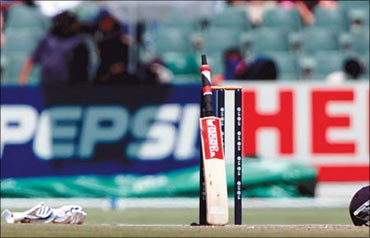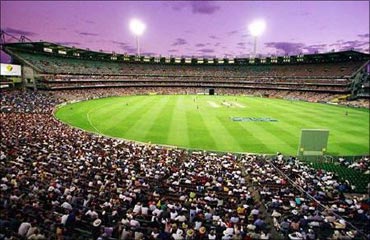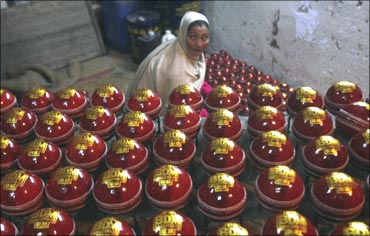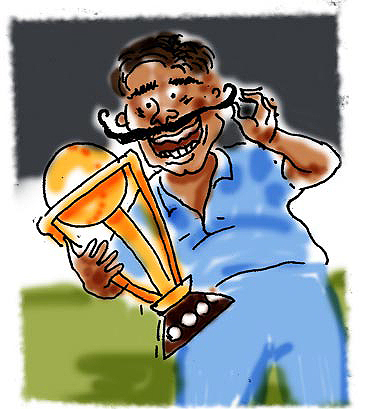Photographs: Reuters Tanmoy Goswami
The Tata Consultancy Services-Smart Manager Case Contest is the oldest and most prestigious competition of its kind in India.
Apart from a one-year free subscription to The Smart Manager, India's first world-class management magazine, winners from the 'manager' and 'student' categories stand to win cash prises of Rs 25,000 each.
All you have to do is read the case, see the question you have to answer on the last slide, . . .
Want to win Rs 25,000? Try solving this case
Photographs: Reuters
It was a problem that he had not envisaged in his worst nightmare, and yet, here it was, all set to spoil the party that had barely begun.
The origins of TCL
TCL was the brainchild of the heads of several small cricketing countries, in response to the growing need for competitive games for their teams.
Though the governing boards in these countries still depended on the World Cricket Organisation for financial support, the increasingly busy international calendar of the top teams in the world made it difficult for the WCO to extend regular fixture support to the smaller teams.
This was causing a general drop in the quality of cricketers produced in the smaller countries, not to mention a decline in interest in the sport.
It also resulted in a larger vicious cycle -- money could not be made from cricket in these countries because there weren't enough high-profile games, and more high-quality teams could not be invited because the overall market for cricket there was not mature enough to support such match-ups on a sustained basis.
. . .
Want to win Rs 25,000? Try solving this case
Photographs: Reuters
In late-2007, Dion Kirkpatrick took charge as TTCC representative in WCO. He had been speaking to a sympathetic few in the WCO about the stagnation of cricket in the tier two countries even before starting in this new role, and now he had direct access to important people.
Kirkpatrick was a widely respected former international cricketer who had decided to settle down in his country of origin -- a TTCC member -- as an administrator, following a very successful career with one of the world's foremost cricket teams.
As he spoke to people in WCO, he realised that there was only one viable solution to lift cricket in TTCC countries without depending too much on the bigger teams: they needed to change the current paradigm of competition.
In other words, they needed to 'lower the bar', play relentlessly among themselves such that the annual calendar never looked devoid of fixtures, generate enough buzz about cricket in their markets through crowd-pulling innovations, so that over a period of time it would become easier for them to attract top-draw cricket teams to their shores.
. . .
Want to win Rs 25,000? Try solving this case
Photographs: Reuters
Everybody agreed that it was better for the morale of TTCC teams to play continuously among themselves, complemented by some bigger games arranged by WCO at specific times of the year, rather than not play enough throughout the year and then get thrashed by the bigger teams during the odd games against them.
A twenty-over league among teams from TTCC countries appeared to be the most logical first step, following the extremely successful template already established in some of the biggest cricketing nations.
Accordingly, Kirkpatrick and the heads of other TTCC countries worked out a basic tournament format; convincing the ten member boards and players of TTCC to play in the tournament was easy.
The road after this was fraught with problems. The biggest challenge obviously was that most TTCC cricketers were amateurs -- they could not be expected to play cricket throughout the year giving up their regular jobs, unless there was a strong financial ecosystem from which they could draw support.
The WCO grants to TTCC, while substantial, could not sustain an ambitious calendar featuring a few hundred cricketers. Cricket was far from being a sellable sport in these countries, so marketing and advertising remained a non-starter.
. . .
Want to win Rs 25,000? Try solving this case
Photographs: Reuters
Kirkpatrick and his TTCC comrades realised that they needed to rope in at least a few big names from world cricket to boost the profile of their initiative.
Help arrives
Help soon arrived from unexpected quarters. In early-2008, a couple of top-draw national teams hit rough weather owing to their allegedly politically motivated selection policies.
Following failed negotiations with the governing boards, these teams saw a mass exodus of senior players -- thirty of them -- who refused to be on contract citing ideological differences.
Owing to public pressure, the boards decided not to ban the players, but the bitter nature of the dispute made these players unattractive in the major cricketing markets of the world -- namely, in the most successful twenty-over leagues run by the sport's superpowers.
Cricket can be a very orthodox sport in spite of its many advancements, and the direct beneficiary in this case was TTCC.
Tipped off by a well-placed representative from one of the two affected teams, TTCC approached the thirty cricketers, many of whom had won world championships, and offered them a chance to play in the proposed league.
. . .
Want to win Rs 25,000? Try solving this case
Photographs: Reuters
The fact that most leagues around the world were unwilling to accommodate these players in their already-established sides as well as the opportunity to be part of a pioneering (almost philanthropic!) opportunity in cricket did the trick.
In April 2008, all thirty players signed up to play for the new league and were allotted teams through an auction -- at fractions of what many of them would have ordinarily earned.
This development had enormous ripple effects in the global cricketing community. Many saw it is a heroic movement -- the blend of 'rebellion' and the beginning of a new era in a traditionally 'underprivileged' cricketing destination lent itself to tremendous media hype.
The tipping point came when three high-profile players who had retired from international cricket between January and April 2008 -- some said prematurely -- joined the chorus supporting the new league.
Following a meeting with Kirkpatrick, they announced in a press conference that they would play and mentor teams in the league without charging a penny.
. . .
Want to win Rs 25,000? Try solving this case
Photographs: Reuters
They led the way for other big names to join in -- some of these players belonged to powerful cricketing countries that had been the 'victim' of global geopolitical equations and found themselves out of favor in the lucrative leagues of the world, while some others had a history of rebellion or injury that had shortened their careers.
Many still commanded a loyal following and had a strong desire to play cricket. This platform presented a novel opportunity to them that they latched on to.
This was unprecedented and shook 'the market' out of its inertia. The prime minister of one of the TTCC countries -- also a media baron and a global business icon -- announced that he will donate $50 million to help develop the new league.
Following his example, three giant national cricket boards -- which had publicly criticized the apparent politicization of team selection -- came forward with major investments.
A television partner was duly found to air the matches around the world, and by December 2008, the Tier Two Cricket League had generated considerable curiosity in the participating countries as well as in the main markets of cricket.
. . .
Want to win Rs 25,000? Try solving this case
Photographs: Reuters
People even compared it with Kerry Packer's pathbreaking innovation in terms of limited-overs cricket, which too had its beginnings in a similar 'rebellion'.
However, Kirkpatrick realised that this innovation was not sustainable. He did not expect the thirty 'rebel' players to be kept out of their national sides for very long, neither could he rely on the largesse of a few individuals or organisations in the long run.
But he also knew that there could be no looking back now and that TTCC could not waste this unexpected bounty lavished on them by sheer luck.
By the time the unique league was finally launched in May 2008, through a glamorous opening ceremony featuring international celebrities, Kirkpatrick and his TTCC friends had decided that it had to be a biannual 'festival of cricket', rather than a tournament branded overtly on its competitive merits.
The two-year window after the first event would give TTCC lobbyists time to promote the league all over the world, find a window in the international calendar, and find sustainable models to run the show in the long run.
They also hoped that TTCC players would give a good account of themselves in the inaugural edition, which would strengthen their credentials to play in the more mainstream leagues of the world. One way or the other, Kirkpatrick believed, this was a quantum leap forward in the history of TTCC.
After the opening night, which had garnered record television viewers around the world, Kirkpatrick slept a happy man. The playing field awaited the first, historical, TCL game.
. . .
Want to win Rs 25,000? Try solving this case
Photographs: Reuters
Things fall apart
At 3 am in the morning, Kirkpatrick woke up to the sound of incoming email on his mobile phone. The email had come from Theodore Weinberger, the head of the TCL administrative committee. 'IT'S A DISASTER, DION!', screamed the subject line of the email. Before he could open the email to read its contents, Weinberger called. It was indeed a disaster.
After the opening celebrations, when the entire TCL family was immersed in a feeling of goodwill and cheerfulness, a blog quietly surfaced under the name 'The Tier Two Sneak'.
The blogger had sent out his first post to more than 200,000 people around the world through Facebook, using the database of fans on the official TCL page.
The post was explosive: it alleged that the blogger, an 'insider', had evidence that the money being used to fund TCL formed part of an international black money trail, which explained 'how so much money could be raised so easily'.
. . .
Want to win Rs 25,000? Try solving this case
Photographs: Reuters
The blogger also claimed that senior TTCC representatives had bought favours from the three big cricket boards and had also broken several foreign exchange control regulations.
To top it all, the blogger alleged that the teams were actually not serious about the cricket at all, taking this just as an opportunity to get some free PR and tour some exotic locations.
According to the long post, all the teams suffered from chronic absenteeism in their meetings and practice sessions, which was kept well hidden from the media.
If the blogger were to be believed, he was all set to disclose more details -- including stories of infighting and more corruption -- an hour before the first game, which was to start at 10am local time.
The media around the world had already started covering the blog prominently, and though no TPL player or official had yet commented on it, the episode threatened to mar the goodwill and even derail the historic tournament even before it began.
. . .
Want to win Rs 25,000? Try solving this case
Photographs: Reuters
As Kirkpatrick stepped inside his office, he was greeted by his team with sullen expressions on their faces.
It was 7:00am. They had two hours before the blogger went public with the next post.
And to make matters worse, the team informed Kirkpatrick that two influential cricketers had withdrawn from the event early in the morning citing 'sudden family emergencies'.
Rumours were rife that more casualties were on their way.
Your question
Propose a plan of action for Kirkpatrick and Co. to deal with this situation.












article